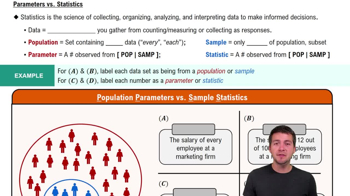Identifying Hypotheses Refer to the data given in Exercise 1 and assume that the requirements are all satisfied and we want to conduct a hypothesis test of independence using the methods of this section. Identify the null and alternative hypotheses.
Table of contents
- 1. Intro to Stats and Collecting Data1h 14m
- 2. Describing Data with Tables and Graphs1h 55m
- 3. Describing Data Numerically2h 5m
- 4. Probability2h 16m
- 5. Binomial Distribution & Discrete Random Variables3h 6m
- 6. Normal Distribution and Continuous Random Variables2h 11m
- 7. Sampling Distributions & Confidence Intervals: Mean3h 23m
- Sampling Distribution of the Sample Mean and Central Limit Theorem19m
- Distribution of Sample Mean - Excel23m
- Introduction to Confidence Intervals15m
- Confidence Intervals for Population Mean1h 18m
- Determining the Minimum Sample Size Required12m
- Finding Probabilities and T Critical Values - Excel28m
- Confidence Intervals for Population Means - Excel25m
- 8. Sampling Distributions & Confidence Intervals: Proportion1h 12m
- 9. Hypothesis Testing for One Sample3h 29m
- 10. Hypothesis Testing for Two Samples4h 50m
- Two Proportions1h 13m
- Two Proportions Hypothesis Test - Excel28m
- Two Means - Unknown, Unequal Variance1h 3m
- Two Means - Unknown Variances Hypothesis Test - Excel12m
- Two Means - Unknown, Equal Variance15m
- Two Means - Unknown, Equal Variances Hypothesis Test - Excel9m
- Two Means - Known Variance12m
- Two Means - Sigma Known Hypothesis Test - Excel21m
- Two Means - Matched Pairs (Dependent Samples)42m
- Matched Pairs Hypothesis Test - Excel12m
- 11. Correlation1h 6m
- 12. Regression1h 50m
- 13. Chi-Square Tests & Goodness of Fit1h 57m
- 14. ANOVA1h 57m
9. Hypothesis Testing for One Sample
Steps in Hypothesis Testing
Problem 9.QQ.1
Textbook Question
Identifying Hypotheses In a randomized clinical trial of adults with an acute sore throat, 288 were treated with the drug dexamethasone and 102 of them experienced complete resolution; 277 were treated with a placebo and 75 of them experienced complete resolution (based on data from “Effect of Oral Dexamethasone Without Immediate Antibiotics vs Placebo on Acute Sore Throat in Adults,” by Hayward et al., Journal of the American Medical Association). Identify the null and alternative hypotheses corresponding to the claim that patients treated with dexamethasone and patients given a placebo have the same rate of complete resolution.
 Verified step by step guidance
Verified step by step guidance1
Step 1: Understand the context of the problem. The claim is about comparing the rates of complete resolution between two groups: those treated with dexamethasone and those given a placebo. This is a hypothesis testing problem involving proportions.
Step 2: Define the null hypothesis (H₀). The null hypothesis represents the assumption that there is no difference in the rates of complete resolution between the two groups. Mathematically, this can be expressed as: , where is the proportion of patients treated with dexamethasone who experienced complete resolution, and is the proportion of patients given a placebo who experienced complete resolution.
Step 3: Define the alternative hypothesis (H₁). The alternative hypothesis represents the claim that the rates of complete resolution are different between the two groups. Mathematically, this can be expressed as: .
Step 4: Note the type of test. Since the alternative hypothesis involves a 'not equal to' comparison (), this is a two-tailed test. The test will evaluate whether the proportions are significantly different in either direction.
Step 5: Prepare for hypothesis testing. To test these hypotheses, you would calculate the test statistic using the sample proportions and sample sizes provided. Then, compare the test statistic to the critical value or use the p-value approach to determine whether to reject the null hypothesis.
 Verified video answer for a similar problem:
Verified video answer for a similar problem:This video solution was recommended by our tutors as helpful for the problem above
Video duration:
1mPlay a video:
Was this helpful?
Key Concepts
Here are the essential concepts you must grasp in order to answer the question correctly.
Null Hypothesis (H0)
The null hypothesis is a statement that there is no effect or no difference between groups in a study. In this context, it posits that the rate of complete resolution of sore throat is the same for patients treated with dexamethasone and those given a placebo. It serves as a baseline for statistical testing, allowing researchers to determine if observed differences are statistically significant.
Recommended video:
Guided course

Step 1: Write Hypotheses
Alternative Hypothesis (H1)
The alternative hypothesis is a statement that indicates the presence of an effect or a difference between groups. In this scenario, it suggests that there is a difference in the rate of complete resolution between patients treated with dexamethasone and those receiving a placebo. This hypothesis is what researchers aim to support through their data analysis, often leading to further investigation if the null hypothesis is rejected.
Recommended video:
Guided course

Step 1: Write Hypotheses
Statistical Significance
Statistical significance refers to the likelihood that a relationship observed in data is not due to random chance. In hypothesis testing, researchers use p-values to determine if the results are statistically significant, typically using a threshold (e.g., p < 0.05). If the null hypothesis is rejected based on significant results, it suggests that the treatment (dexamethasone) may have a real effect on the resolution of sore throat compared to the placebo.
Recommended video:
Guided course

Parameters vs. Statistics

 6:21m
6:21mWatch next
Master Step 1: Write Hypotheses with a bite sized video explanation from Patrick
Start learningRelated Videos
Related Practice
Textbook Question
